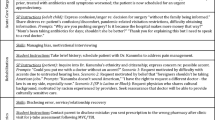Abstract
Standardized Patients can be trained and utilized as educators in realms that reach beyond the commonly used communication. These expanded applications are rooted in the communication training that an SP receives in your program. Consider the utilization of SPs to instruct and assess learners in their communication and physical exam skills. Depending on the cases you already employ this may not be far from your current implementation. The true expansion into additional applications begins with your inclusion of instruction or assessment sessions explicitly aimed to evaluate the physical examination skills. During this chapter you will find information about the recruitment, hiring, and training of Physical Exam Teaching Associates (PETA), Gynecological Teaching Associates (GTA), and Male Urogenital Teaching Associates (MUTA), as well as the design and implementation of these programs within a simulation center. Each of these rolls includes additional extensive training to instruct, facilitate learning, and assess the participants in the sessions. Every program will utilize these roles differently and therefore you will find separate considerations for the design and implementation of sessions based on their intended design. These may include sessions used to instruct learners on new physical exam techniques and sessions used for either formative or summative assessments.
Access this chapter
Tax calculation will be finalised at checkout
Purchases are for personal use only
Similar content being viewed by others
Abbreviations
- ASPE:
-
Association of Standardized Patient Educators
- COMLEX-USA:
-
Comprehensive Osteopathic Medical Licensing Examination.
- GTA:
-
Gynecological Teaching Associate
- GUTA:
-
Genitourinary Teaching Associate
- INACSL:
-
International Nursing Association for Clinical Simulation & Learning
- MUTA:
-
Male Urological Teaching Associate
- OB/GYN:
-
Obstetrics and Gynecology
- OSCE:
-
Objective Structured Clinical Examination
- PETA:
-
Physical Examination Teaching Associate
- SMART:
-
Specific. Measurable. Achievable. Relevant. Time-bound
- SME:
-
subject matter expert
- SOBP:
-
Standards of Best Practice
- SP:
-
Standardized/Simulated Patient
- SPE:
-
Standardized Patient Educator
- SSH:
-
Society for Simulation in Healthcare
- TA:
-
Teaching Associate
- USMLE:
-
United States Medical Licensing Examination
References
Lopreiato JO (editor), Downing D, Gammon W, Lioce L, Sittner B, Slot V, Spain AE (Associate editors) and the Terminology & Concepts Working Group. Healthcare simulation dictionary. 2016. Retrieved from http://www.ssih.org/dictionary.
Kretzschmar RM. Evolution of the gynecology teaching associate: an education specialist. Am J Obstet Gynecol. 1978;131(4):367–73.
Lewis KL, Bohnert CA, Gammon WL, et al. The Association of Standardized Patient Educators (ASPE) standards of best practice (SOBP). Adv Simul. 2017;2(10) https://doi.org/10.1186/s41077-017-0043-4.
Nelson LH. Use of professional patients in teaching pelvic examinations. Obstet Gynecol. 1978;52(5):630–3.
Kretzschmar RM, Guthrie DS. Why not every school? J Am Med Womens Assoc. 1984;39(2):43–5.
Costanza ME, Luckmann R, Quirk ME, Clemow L, White MJ, Stoddard AM. The effectiveness of using standardized patients to improve community physician skills in mammography counseling and clinical breast exam. Prev Med. 1999;29(4):241–8. https://doi.org/10.1006/pmed.1999.0544.
Theroux R, Pearce C. Graduate students’ experiences with standardized patients as adjuncts for teaching pelvic examinations. J Am Acad Nurse Pract. 2006;18(9):429–35. https://doi.org/10.1111/j.1745-7599.2006.00158.x.
Pradhan A, Ebert G, Brug P, Swee D, Ananth CV. Evaluating pelvic examination training: does faculty involvement make a difference? A randomized controlled trial. Teach Learn Med. 2010;22(4):293–7. https://doi.org/10.1080/10401334.2010.512831.
Grankvist O, Olofsson AD, Isaksson RM. Can physicians be replaced with gynecological teaching women to train medical students in their first pelvic examination? A pilot study from Northern Sweden. Patient Educ Couns. 2014;96(1):50–4. https://doi.org/10.1016/j.pec.2014.04.013.
Kleinman DE, Hage ML, Hoole AJ, Kowlowitz V. Pelvic examination instruction and experience: a comparison of laywoman-trained and physician-trained students. Acad Med. 1996;71(11):1239–43. https://doi.org/10.1097/00001888-199611000-00021.
Godkins TR, Duffy D, Greenwood J, Stanhope WD. Utilization of simulated patients to teach the routine pelvic examination. J Med Educ. 1974;49(12):1174–8.
Bokken L, Rethans JJ, Scherpbier A, van der Vleuten C. Strengths and weaknesses of simulated and real patients in the teaching of skills to medical students: a review. Simul Healthc. 2008;3(3):161–9. https://doi.org/10.1097/SIH.0b013e318182fc56.
Beckmann CRB, Sharf BF, Barzansky BM, Spellacy WN. Student response to gynecologic teaching associates. Am J Obstet Gynecol. 1986;155(2):301–6. https://doi.org/10.1016/0002-9378(86)90814-8.
Carr SE, Carmody D. Outcomes of teaching medical students core skills for women’s health: the pelvic examination educational programs. Am J Obstet Gynecol. 2004;190:1382–7. https://doi.org/10.1016/j.ajog.2003.10.697.
Guenther SM, Laube DW, Matthes S. Effectiveness of the gynecology teaching associate in teaching pelvic examination skills. J Med Educ. 1983;58:67–9.
Hale RW, Schiner W. Professional patients: an improved method of teaching breast and pelvic examination. J Reprod Med. 1977;19(3):163–6.
Nelson LH. Use of professional patients in teaching pelvic examinations. Obstet Gynecol. 1978;52(5):630–3.
Jhja V, Setna Z, Al-Hity A, Quinton ND, Roberts TE. Patient involvement in teaching and assessing intimate examination skills: a systematic review. Med Educ. 2010;44:347–57. https://doi.org/10.1111/j.1365-2923.2009.03608.x.
Occupational Safety and Health Administration. Glossary [Internet]. Available from: https://www.osha.gov/SLTC/etools/hospital/glossary.html
Hasle JL, Anderson DS, Szerlip HM. Analysis of the costs and benefits of using standardized patietns to help teach physical diagnosis. Acad Med. 1994;69(7):567–70. https://doi.org/10.1097/00001888-199407000-00013.
Siwe K, Wijma K, Stjernquist M, Wijma B. Medical students learning the pelvic examination: comparison of outcome in terms of skills between a professional patient and a clinical patient model. Patient Educ Couns. 2007;68(3):211–7. https://doi.org/10.1016/j.pec.2007.05.007.
Author information
Authors and Affiliations
Corresponding author
Editor information
Editors and Affiliations
Rights and permissions
Copyright information
© 2020 Springer Nature Switzerland AG
About this chapter
Cite this chapter
Weaks, C., Hopkins, H., Lyman, L., George, S.W. (2020). Broader Applications of Communication: Using the Human Body for Teaching and Assessment. In: Gliva-McConvey, G., Nicholas, C.F., Clark, L. (eds) Comprehensive Healthcare Simulation: Implementing Best Practices in Standardized Patient Methodology. Comprehensive Healthcare Simulation. Springer, Cham. https://doi.org/10.1007/978-3-030-43826-5_12
Download citation
DOI: https://doi.org/10.1007/978-3-030-43826-5_12
Published:
Publisher Name: Springer, Cham
Print ISBN: 978-3-030-43825-8
Online ISBN: 978-3-030-43826-5
eBook Packages: MedicineMedicine (R0)



